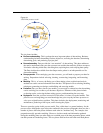
36
Chapter 4
The PCA/Factor node provides powerful data-reduction techniques to reduce
the complexity of your data. Principal components analysis (PCA) finds linear
combinations of the input fields that do the best job of capturing the variance in the
entire set of fields, where the components are orthogonal (perpendicular) to each
other. Factor analysis attempts to identify underlying factors that explain the pattern
of correlations within a set of observed fiel ds. For both approaches, the goal is to
find a small number of derived fields that effectively summarizes the information in
the original set of fields.
The Feature Selection node screens input fields for removal based on a set of criteria
(such as the percentage of missing values); it then ranks the importance of remaining
inputs relative to a specified target. For example, given a data set with hundreds of
potential inputs, which are most likely to be useful in modeling patient outcomes?
Discriminant analysis makes more stringent assumptions than logistic regression but
can be a valuable alternative o r supplement to a logistic regression analysis when
those assumptions ar e met.
Logistic regression is a statistical technique for classifyin g records based on values
of input fields. It is analogous to linear regression but takes a categorical target field
instead of a numeric range.
The Generalized Linear model expands the general linear model so that the
dependent variable is linearly related to the factors and covariates through a specified
link function. Moreover, the model allows for the dependent variable to have a
non-normal distribution. It covers the functionality of a wide number of statistical
models, including linear regression, logistic regressio n, loglinear m odels for count
data, and interval-censored survival models.
A generalized linear mixed model (GLMM) extends the linear model so that the target
can have a non-normal distribution, is linearly related to the factors and covariates via
a specified link function, and so that the observations can be correlated. Generalized
linear mixed models cover a wide variety of models, from simple linear regression to
complex multilevel models fo r non-normal longitudinal data.
The Cox regression node enables you to build a survival model for time-to-event data
in the presence of censored records. The model produces a survival functio n that
predicts the probability that the event of interest has occurred at a given time (t)
for given values of the i nput variables.
The Support Vector Machine (SVM) node enables you to classify data into one of
two groups withou t overfitting. SVM works well with wide data sets, such as those
with a very large number of input fields.
The Bayesian Network node enables you to build a probability model by combinin g
observed and recorded evidence with real-world knowledge to establish the likelihood
of occurrences. The node focuses on Tree Augmented Naïve Bayes (TAN) and
Markov Blanket networks that are primarily used for classification.


















